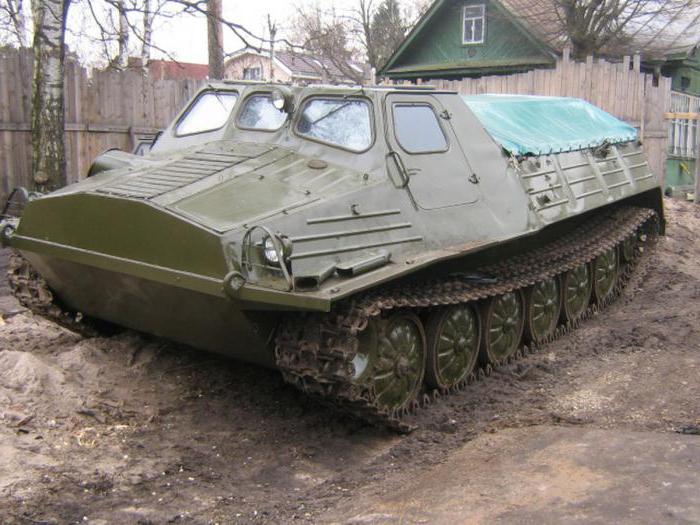In the 50s in the USSR there was an intensive development of various remote areas of the country. Existing wheeled vehicles, despite continuous improvement, were not suitable for movement in difficult climatic and road conditions. The country and the army needed a passable car capable of withstanding operation at ambient temperatures from minus 45 degrees to plus 45.
Car making
In such conditions, the most suitable vehicle was a caterpillar all-terrain vehicle for special purposes. The development of a universal caterpillar tractor was carried out at KhTZ (Kharkov Tractor Plant) under the in-plant designation “Project 21”. The design stage took about four years, and in 1961 the first two products were assembled. The car received the designation GTT and since the spring of 1962 it has been mass-produced at the Rubtsovsk Machine Plant. The army became the main customer of the tractor.

The characteristics of the GTT all-terrain vehicle allowed to abandon the operation of a number of non-tracked tractors, thereby simplifying the maintenance and supply of spare parts for fleets in remote areas of the country. The machine with its own weight a little more than 8 tons could carry up to 2 tons of cargo. If necessary, 21 people could be accommodated in the cargo compartment measuring 3.5 m * 1.8 m. The all-terrain vehicle was equipped with a coupling device for towing trailers with a total weight of up to 4 tons.
Body and chassis design
The body of the GTT all-terrain vehicle had a supporting circuit and was manufactured by welding. The case had a power frame, to which the outer sheets were attached. Since one of the requirements of the customers was to ensure buoyancy, the lower part of the machine was sealed.
Inside there were two bulkheads dividing the hull into three compartments - powertrain compartments, passenger and cargo. The gearbox and on-board friction clutches were located in the bow of the GTT all-terrain vehicle, the engine was closer to the central part of the passenger cabin. To the left of the engine cover was the seat of the driver. It was separated from the bow by a septum. Behind the mechanic and to the right of the engine there were three more passenger seats.
The cargo compartment was located behind the engine and did not have a passenger compartment. The compartment was open and could be covered with a tarp.
The chassis of the GTT all-terrain vehicle had six road wheels per side. The rollers had external cushioning in the form of a rubber ring on the outside of the roller. Driving wheels with a gear ring were located in front. The caterpillar consisted of 92 tracks connected by floating fingers. The tracks were tensioned using a movable guide wheel located at the rear.
Suspension of road wheels torsion bar. The movement afloat was provided by the rotation of the tracks and was facilitated by special removable shields.
Tractor transmission
As a power unit on a GTT crawler all-terrain vehicle, a 200-horsepower diesel engine of the V6A model was used. The in-line six-cylinder engine was half the famous B2 tank engine. Due to its tank origin, the engine had a combined starting system - from an electric starter and compressed air. Fuel consumption was quite large - up to 110 liters per 100 km.
The engine was equipped with a five-speed manual gearbox. Partial or complete braking of one of the tracks with the help of friction clutches was used to make a turn on the GTT all-terrain vehicle. Final drives were equipped with planetary gearboxes. The maximum speed did not exceed 45 km / h forward and up to 6.5 km / h back.
Modifications and Development
The first years of production went at an accelerating pace. By the mid-60s, the plant collected up to 120 cars per month. At the end of the 60s, a civilian version of the GTT all-terrain vehicle appeared - a rafting machine. In addition to it, there was a version of the GTTS equipped with a fifth wheel coupling from a ZIL-157V truck tractor.
By the end of the 70s, the production of GTT was completely transferred to Semipalatinsk (Kazakhstan) at the Rubtsovsky plant branch.
In the 90s, work was underway to modernize the machine. In particular, they installed a more economical and modern diesel engine YaMZ-238. The car received the designation GTTB. The engine itself was slightly shifted back, increasing passenger accommodation conditions. But thanks to the new engine, the payload has increased to 2,500 kg, and the maximum speed is up to 50-55 km / h.
At the same time, the material of the shock-absorbing rings of the track rollers was changed to more wear-resistant polyurethane.
In 2007, an elongated version appeared with seven track rollers under the designation GTTBU. This version of the machine is currently being produced.